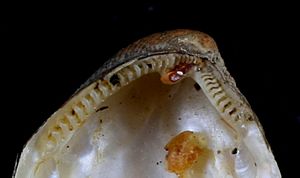Hinge teeth facts for kids
Hinge teeth are special bumps and grooves found on the inside edge of a bivalve's shell. A bivalve is a type of mollusc that has two shell halves, called "valves." These two halves are connected at the top by a strong, stretchy band called a ligament.
Imagine trying to open and close a box with two lids. The shell needs to open just enough for the bivalve to stick out its foot or siphons. Then, it needs to close tightly again. The hinge teeth make sure the two shell halves fit together perfectly and don't slide out of place when opening or closing. These teeth are located along the same line as the ligament.
Even though the two shell halves of a bivalve look very similar, the hinge teeth on the left and right sides might be shaped a little differently. This helps them lock together like puzzle pieces. Different kinds of bivalves often have unique patterns of hinge teeth. This makes them very useful for scientists to identify and classify different species.
Contents
What are Hinge Teeth?
Hinge teeth are like tiny interlocking parts on the inside of a bivalve's shell. They are found right where the two shell halves meet. These teeth help the shell open and close smoothly. Without them, the shell halves might twist or separate, which would be a big problem for the animal inside.
How Hinge Teeth Work
When a bivalve opens its shell, the ligament stretches. The hinge teeth slide past each other, keeping the two halves aligned. When the bivalve closes its shell, the teeth lock back into place. This strong connection protects the soft body of the mollusc from predators and the environment.
Hinge Teeth in Brachiopods
Bivalves are not the only shelled animals with hinge teeth. Another group of marine animals, called brachiopods, also has them. Brachiopods are a different phylum from molluscs, but they also have two shells.
Articulate Brachiopods
In the traditional way of classifying brachiopods, there's a group called the Articulata. These brachiopods have special toothed hinges that connect their two shells. These teeth work much like those in bivalves, helping the shells to open and close properly.
Inarticulate Brachiopods
However, another group of brachiopods, called the Inarticulata, does not have hinge teeth. For these brachiopods, their two shell parts are held together only by strong muscles. This shows that different animals have found different ways to keep their shells connected and working.
Images for kids
-
Mytilidae hinge
-
Ostreidae hinge
-
Pectinidae hinge
-
Veneridae: Pitar hinge
-
Cardiidae hinge




















